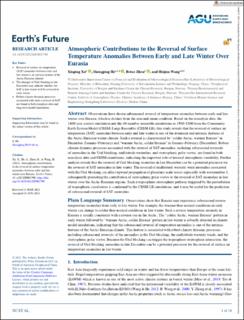| dc.contributor.author | Xu, Xinping | |
| dc.contributor.author | He, Shengping | |
| dc.contributor.author | Zhou, Botao | |
| dc.contributor.author | Wang, Huijun | |
| dc.date.accessioned | 2022-12-29T14:25:19Z | |
| dc.date.available | 2022-12-29T14:25:19Z | |
| dc.date.created | 2022-09-16T14:14:11Z | |
| dc.date.issued | 2022 | |
| dc.identifier.issn | 2328-4277 | |
| dc.identifier.uri | https://hdl.handle.net/11250/3039933 | |
| dc.description.abstract | Observations have shown subseasonal reversal of temperature anomalies between early and late winter over Eurasia, which is distinct from the seasonal mean condition. Based on the reanalysis data, the 1800-year control simulation and the 40-member ensemble simulations in 1920–2100 from the Community Earth System Model (CESM) Large Ensemble (CESM-LE), this study reveals that the reversal of surface air temperature (SAT) anomalies between early and late winter is one of the dominant and intrinsic features of the Arctic-Eurasian winter climate. Such a reversal is characterized by “colder Arctic, warmer Eurasia” in December (January–February) and “warmer Arctic, colder Eurasia” in January–February (December). Robust climate dynamic processes associated with the reversal of SAT anomalies, including subseasonal reversals of anomalies in the Ural blocking, midlatitude westerlies, and stratospheric polar vortex, are found in both reanalysis data and CESM simulations, indicating the important role of internal atmospheric variability. Further analysis reveals that the reversal of Ural blocking anomalies in late December can be a potential precursor for the reversal of SAT anomalies in late winter. The reversal of midlatitude westerly wind anomalies associated with the Ural blocking can affect upward propagation of planetary-scale waves especially with wavenumber 1, subsequently promoting the contribution of stratospheric polar vortex to the reversal of SAT anomalies in late winter over the Arctic-Eurasian regions. Such a troposphere-stratosphere pathway triggered by the perturbation of tropospheric circulations is confirmed by the CESM-LE simulations, and it may be useful for the prediction of subseasonal reversal of SAT anomalies. | en_US |
| dc.language.iso | eng | en_US |
| dc.publisher | Wiley | en_US |
| dc.rights | Attribution-NonCommercial-NoDerivatives 4.0 Internasjonal | * |
| dc.rights.uri | http://creativecommons.org/licenses/by-nc-nd/4.0/deed.no | * |
| dc.title | Atmospheric Contributions to the Reversal of Surface Temperature Anomalies Between Early and Late Winter Over Eurasia | en_US |
| dc.type | Journal article | en_US |
| dc.type | Peer reviewed | en_US |
| dc.description.version | publishedVersion | en_US |
| dc.rights.holder | Copyright 2022 the authors | en_US |
| dc.source.articlenumber | e2022EF002790 | en_US |
| cristin.ispublished | true | |
| cristin.fulltext | original | |
| cristin.qualitycode | 1 | |
| dc.identifier.doi | 10.1029/2022EF002790 | |
| dc.identifier.cristin | 2052546 | |
| dc.source.journal | Earth's Future | en_US |
| dc.relation.project | Norges forskningsråd: 325440 | en_US |
| dc.identifier.citation | Earth's Future. 2022, 10 (8), e2022EF002790. | en_US |
| dc.source.volume | 10 | en_US |
| dc.source.issue | 8 | en_US |

